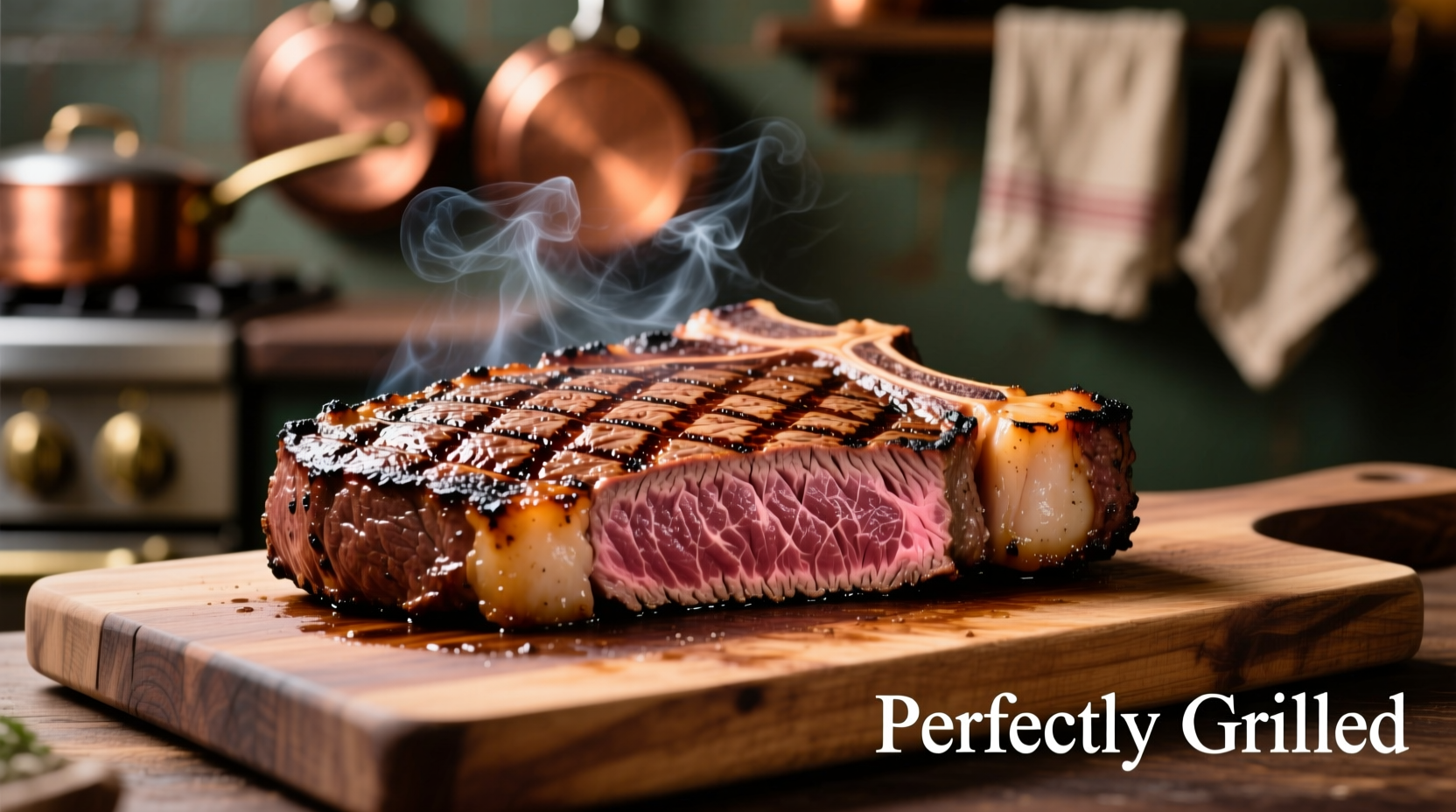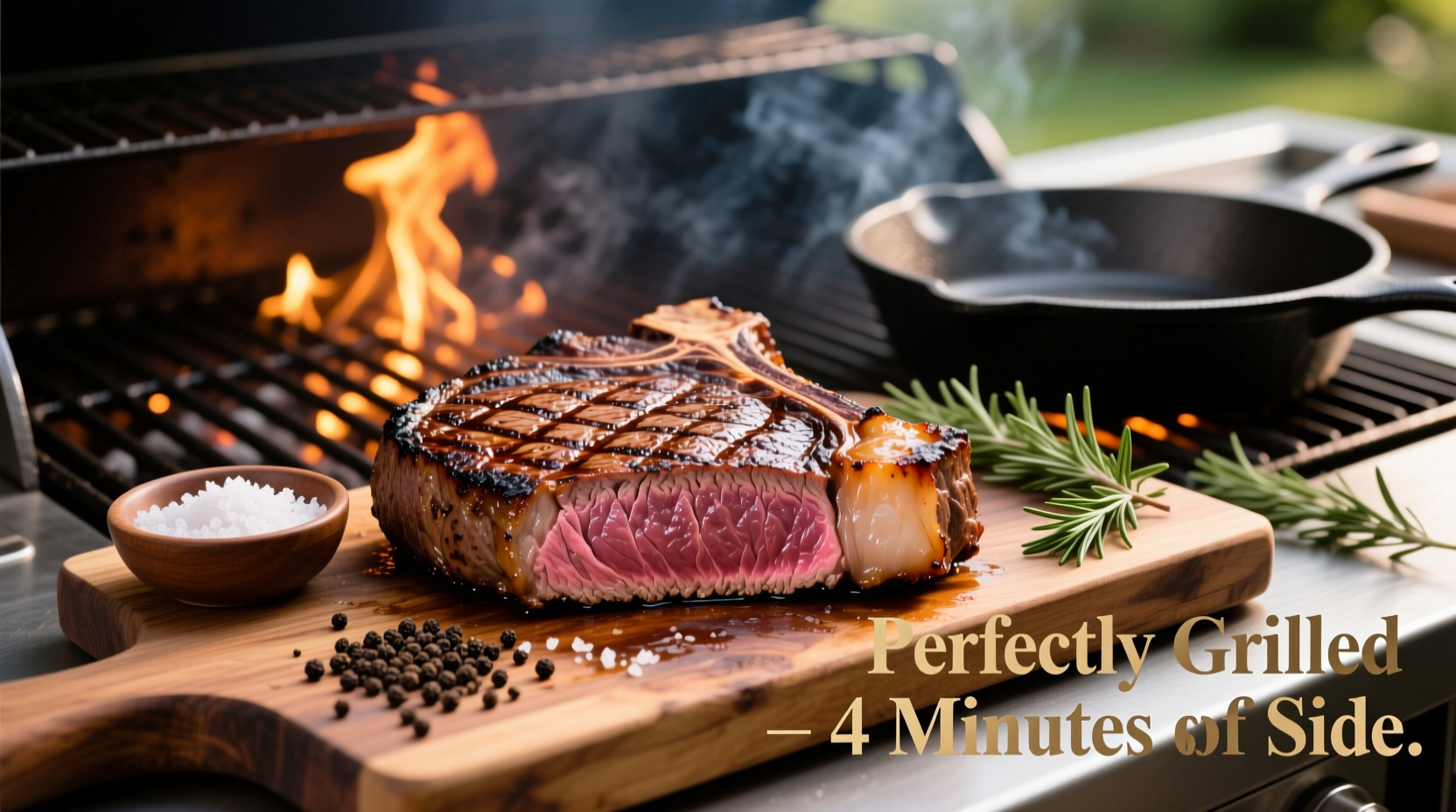Grill a perfect medium-rare NY strip steak in 25 minutes with these professional techniques: preheat grill to 450-500°F, season with coarse salt 45 minutes before cooking, sear 4-5 minutes per side, and rest 8 minutes. Internal temperature should reach 130-135°F for medium-rare.
Nothing beats the sizzle of a perfectly grilled New York strip steak. This guide delivers restaurant-quality results in your backyard, combining culinary science with practical grilling wisdom. Whether you're hosting a summer barbecue or craving a special dinner, these techniques ensure a flavorful, juicy steak with that coveted charred crust every time.
| Doneness Level | Grill Time (1.5" thick) | Internal Temp | Resting Time |
|---|---|---|---|
| Medium-Rare | 4-5 min per side | 130-135°F | 8 minutes |
| Medium | 5-6 min per side | 140-145°F | 10 minutes |
| Medium-Well | 6-7 min per side | 150-155°F | 12 minutes |
Why This Method Works: The Science Behind Perfect Grilled Steak
Understanding meat science transforms your grilling results. NY strip steaks, cut from the short loin, contain moderate marbling that renders at 130-140°F, creating that signature beefy flavor. The Maillard reaction—the chemical process creating that delicious brown crust—occurs most effectively between 300-500°F. USDA Food Safety and Inspection Service confirms that beef is safe to eat at 145°F with a 3-minute rest, though most steak enthusiasts prefer lower temperatures for optimal texture (source).
Pre-Grill Preparation: Setting Up for Success
Proper preparation makes the difference between good and exceptional steak. Remove your NY strip from the refrigerator 45-60 minutes before grilling. This critical step allows the meat to come closer to room temperature, preventing the common mistake of a cold center with an overcooked exterior. Pat the steak thoroughly dry with paper towels—moisture is the enemy of proper searing.
Season generously with coarse kosher salt (about 1 teaspoon per pound) and freshly ground black pepper. For optimal flavor development, salt your steak at least 45 minutes before cooking. This allows the salt to penetrate beyond the surface, seasoning the meat internally rather than just creating a salty crust. Consider adding garlic powder or smoked paprika for extra depth, but keep the seasoning simple to highlight the steak's natural flavor.

Grill Setup and Temperature Control
Direct high heat creates the essential sear while indirect heat allows for controlled cooking. For charcoal grills, arrange coals for a two-zone fire—pile most coals on one side for direct heat, leaving the other side empty for indirect cooking. For gas grills, preheat all burners to high, then turn off one burner to create your indirect zone.
Preheat your grill to 450-500°F—the ideal temperature range for proper searing without burning. Use the hand test: you should only be able to hold your hand 5 inches above the grates for 2-3 seconds. Clean and oil the grates thoroughly using tongs and a folded paper towel dipped in vegetable oil to prevent sticking.
Cooking Process: Step-by-Step Instructions
Place the NY strip steak directly over the high-heat zone. Close the lid and let it sear undisturbed for 4-5 minutes. Resist the urge to move or press down on the steak—this allows proper crust formation. After the initial sear, rotate the steak 90 degrees to create attractive crosshatch grill marks, then cook for another minute.
Flip the steak and repeat on the other side. For thicker cuts (over 1.5 inches), after the second side has seared for 3-4 minutes, move the steak to the indirect heat zone with the lid closed. Continue cooking until your desired internal temperature is reached, checking with an instant-read thermometer inserted horizontally into the thickest part.
Doneness Indicators: Beyond the Thermometer
While a thermometer provides precision, understanding tactile cues builds confidence. The finger test compares the firmness of your steak to different parts of your hand:
- Raw: Like the fleshy area below your thumb when hand is relaxed
- Medium-rare: Like the same area when thumb touches index finger
- Medium: Like the area when thumb touches middle finger
- Well-done: Like the area when thumb touches pinky
Remember that carryover cooking will raise the internal temperature 5-10°F during resting, so remove your steak from the grill 5°F below your target temperature.
Resting and Serving: The Critical Final Step
Resting allows the juices to redistribute throughout the meat. Place your grilled NY strip steak on a cutting board or warm plate, tented loosely with foil. For a standard 1-1.5 inch thick steak, rest for 8 minutes—thicker cuts may need 10-12 minutes. Cutting too soon releases precious juices onto the cutting board rather than staying in the meat.
Slice against the grain for maximum tenderness—NY strip has a distinct grain pattern running lengthwise. Cut 1/2 inch thick slices perpendicular to this grain. Serve immediately with a pat of compound butter or a simple finishing salt for enhanced flavor.
Troubleshooting Common Grilling Issues
Flare-ups: Move steak to indirect heat zone immediately. Keep a spray bottle of water nearby, but use sparingly as excessive water can create steam that prevents proper searing.
Uneven cooking: For steaks with irregular thickness, position the thicker portion toward the hotter part of the grill. Consider the "butterflying" technique for extremely uneven cuts.
Dry steak: This usually indicates overcooking or insufficient resting time. NY strip should have an internal temperature no higher than 145°F for medium. Remember that carryover cooking continues after removal from heat.
When This Method Works Best (and Limitations)
This technique delivers optimal results for NY strip steaks between 1-1.5 inches thick. Thinner cuts (under 1 inch) require reduced cooking time—approximately 3 minutes per side for medium-rare. For steaks thicker than 1.75 inches, consider the reverse sear method: cook indirectly at 275°F until 115°F internally, then sear over high heat.
Environmental factors impact grilling success. At high altitudes (above 3,000 feet), cooking times increase by 25% due to lower atmospheric pressure. Humidity levels above 70% can affect grill temperature stability—monitor your thermometer closely and be prepared to adjust cooking times accordingly.
Frequently Asked Questions
Should I oil the steak before grilling?
No, oiling the steak directly can cause flare-ups. Instead, oil the grill grates using tongs and a paper towel dipped in vegetable oil. The natural fats in the NY strip will render during cooking, providing sufficient lubrication.
How long should I let my steak rest after grilling?
Rest your NY strip steak for 8 minutes for standard 1-1.5 inch thickness. Thicker cuts (over 1.75 inches) need 10-12 minutes. Resting allows juices to redistribute throughout the meat, resulting in a significantly juicier steak when sliced.
What's the best way to check doneness without a thermometer?
Use the finger test: compare steak firmness to the fleshy area below your thumb. Relaxed hand = raw; thumb to index finger = medium-rare; thumb to middle finger = medium; thumb to pinky = well-done. However, an instant-read thermometer remains the most accurate method.
Can I use this method for frozen steak?
For best results, always thaw steak completely before grilling. Frozen steak leads to uneven cooking—the exterior overcooks while the center remains frozen. Thaw in the refrigerator for 24 hours before cooking, or use the cold water method (sealed bag in cold water) for 1-2 hours.











 浙公网安备
33010002000092号
浙公网安备
33010002000092号 浙B2-20120091-4
浙B2-20120091-4